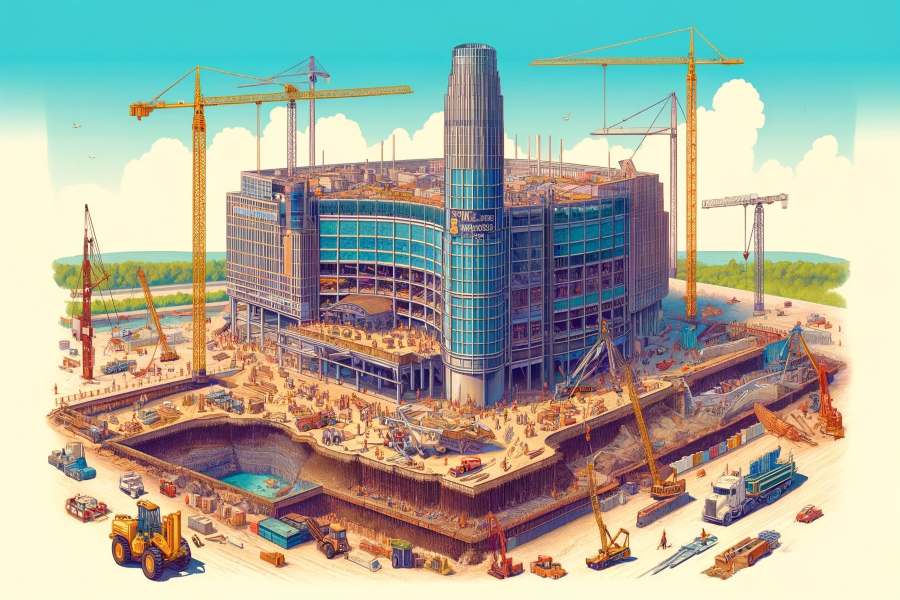The Mall of America, located in Bloomington, Minnesota, stands as a testament to architectural ingenuity and economic ambition. Since its opening in 1992, it has been a premier shopping and entertainment destination, drawing millions of visitors each year.
But behind its grand facades and extensive array of shops lies a fascinating story of its construction—a story of meticulous planning, massive financial investments, and years of labor. In this article, we explore how long it took to build the Mall of America, delving into the timeline, challenges, and remarkable achievements that characterized this monumental project.
How Long Did It Take to Build the Mall of America
The construction of the Mall of America took approximately three years. The planning phase began in the mid-1980s, with developers securing land, financing, and necessary approvals. Actual construction started in June 1989 and involved extensive groundwork, structural development, and interior work. Despite challenges like harsh weather and logistical hurdles, the project progressed steadily. The grand opening took place on August 11, 1992, marking the culmination of years of meticulous planning and hard work. Today, the Mall of America is a testament to visionary development and remains a major shopping and entertainment destination.
The Planning Phase of the Mall of America
The journey to build the Mall of America began long before the first brick was laid. The planning phase was critical in ensuring the project’s success. This stage involved acquiring the land, securing financing, and designing the mall’s layout.
The idea for the Mall of America originated in the early 1980s when the Ghermezian brothers, Canadian developers, envisioned a mega-mall in the U.S. They selected Bloomington, Minnesota, due to its strategic location and available space. Negotiations with local authorities and stakeholders were essential. to gain the necessary approvals.
Securing financing for such a colossal project required innovative strategies. The developers attracted investments from various sources, including banks and private investors. The estimated cost was around $650 million, a substantial amount then.
Designing the mall was an intricate process. The architectural firm Triple Five Group took on the task, of of envisioning a mixed-use complex with retail, entertainment, and dining options. The design had to accommodate future expansions and ensure a seamless visitor experience.
By the mid-1980s, with land secured and designs approved, the stage was set for construction. This phase laid the groundwork for an iconic American landmark, showcasing the power of vision and collaboration.
Construction Timeline and Milestones
- Breaking Ground and Early Construction Construction officially began in June 1989. The first significant task was excavating the site and preparing the foundation. Given the mall’s scale, this involved extensive groundwork to ensure stability and durability.
- Structural Development By late 1989, the structural framework began to take shape. Steel beams, concrete pillars, and expansive roofing structures were erected, creating the skeleton of the mall. This stage required meticulous coordination among various construction teams.
- Interior Work and Utilities As the exterior structure neared completion, the focus shifted to the interior. Installing electrical systems, plumbing, and HVAC was crucial for operational efficiency. This phase also included laying out the vast retail spaces, food courts, and entertainment areas.
- Final Touches and Inspections The final months before the grand opening were dedicated to finishing touches. This included interior decor, signage, and landscaping around the mall. Rigorous inspections ensured safety and compliance with building codes.
- Grand Opening and Public Reception On August 11, 1992, the Mall of America opened its doors. The grand opening attracted significant media attention and visitors from across the nation. The mall quickly became a cultural and economic hub.
Challenges Faced During Construction
- Dealing with Weather Conditions: Minnesota’s weather posed significant challenges during construction. Harsh winters and unpredictable weather patterns often delay progress. Construction teams had to adapt to these conditions, employing innovative techniques to maintain the schedule.
- Managing Supply Chains: The scale of the Mall of America required a vast amount of materials. Coordinating the supply chain to ensure timely delivery of construction materials was a logistical challenge. Any delays could have significantly impacted the construction timeline.
- Ensuring Worker Safety: With thousands of workers on-site, maintaining safety was paramount. The construction management team implemented strict safety protocols and regular training sessions to minimize accidents and injuries.
- Adhering to Budget Constraints: Staying within budget was a constant concern. The developers had to balance quality and cost, ensuring that the project did not exceed its financial limits. This involved careful planning and regular financial assessments.
- Navigating Bureaucratic Hurdles: Securing permits and meeting regulatory requirements were ongoing challenges. The developers worked closely with local government agencies to ensure compliance with all legal and environmental standards.
Economic and Social Impact
Economic Growth and Job Creation
The Mall of America significantly boosted the local economy. During construction, it created thousands of jobs, both directly and indirectly. Upon completion, it continued to generate employment opportunities in retail, hospitality, and maintenance.
Tourism and Local Business Support
Since its opening, the mall has been a major tourist attraction, drawing visitors from around the world. This influx of tourists has benefited local businesses, from hotels to restaurants, contributing to the region’s economic vitality.
Community Engagement and Cultural Influence
The Mall of America has become more than just a shopping center; it’s a cultural landmark. It hosts various events, from concerts to educational programs, fostering community engagement. Its diverse array of attractions, including an indoor amusement park, caters to all age groups.
Real Estate Development
The success of the Mall of America spurred further real estate development in the surrounding area. New residential and commercial projects emerged, transforming Bloomington into a bustling urban center.
Environmental Considerations
Building a mega-mall had environmental implications. The developers implemented sustainable practices, such as efficient energy systems and waste management protocols, to minimize the mall’s ecological footprint.
How Can a Father Lose Visitation Rights
Failure to Follow Court Orders
Visitation rights can be lost if a father consistently fails to follow court-ordered visitation schedules. This includes being late, missing visits, or not adhering to the terms set by the court.
Substance Abuse Issues
If a father is found to be abusing drugs or alcohol, it can result in the loss of visitation rights. Courts prioritize the child’s safety and well-being, and substance abuse poses a significant risk.
Evidence of Abuse or Neglect
Any evidence of physical, emotional, or sexual abuse can lead to a father losing visitation rights. Courts take allegations of abuse seriously and act swiftly to protect the child.
Criminal Activity
Engagement in criminal activities can result in losing visitation rights. A father’s criminal record, particularly involving violent or dangerous behavior, can be grounds for the court to restrict or terminate visitation.
Mental Health Concerns
Severe mental health issues that impact a father’s ability to care for his child can also lead to the loss of visitation rights. Courts may require evidence of stability and treatment before considering reinstatement of visitation.
Conclusion
The construction of the Mall of America, from the initial planning stages to its grand opening, is spanned approximately seven years. The actual building process took about three years, from 1989 to 1992.
This monumental project required extensive planning, collaboration, and perseverance, resulting in an iconic landmark that continues to attract millions of visitors annually. The Mall of America stands as a testament to human ingenuity and the power of visionary thinking.
FAQs
Q: How long did it take to build the Mall of America?
A: The actual construction of the Mall of America took about three years, from 1989 to 1992.
Q: What were some challenges faced during the construction of the Mall of America?
A: Challenges included dealing with Minnesota’s harsh weather, managing supply chains, ensuring worker safety, adhering to budget constraints, and navigating bureaucratic hurdles.
Q: What is the economic impact of the Mall of America?
A: The Mall of America has significantly boosted the local economy by creating jobs, attracting tourists, supporting local businesses, and spurring further real estate development.
Q: What sustainable practices were implemented in the construction of the Mall of America?
A: The developers used efficient energy systems and waste management protocols to minimize the environmental impact of the mall.
Q: How has the Mall of America influenced the community?
A: The Mall of America has become a cultural landmark, hosting events and programs that engage the community and attract diverse visitors from around the world.











Leave a Reply